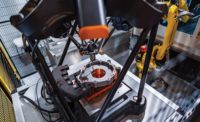The Benefits of Automation
The five reasons to consider, and have been considered for decades, about automation.

The linchpin of automation—since before it was even referred to as such—is in its obvious benefits in increased efficiency and accuracy and its ultimate reduction in cost, time and waste. It’s been true since the time of Ford and his assembly line to our modern manufacturing floors utilizing sensors, software, artificial intelligence, and deep learning. None truer than in the quality control segment, particularly 3D and traditional scanning.
There are five benefits to automation in the manufacturing environment that have been documented time and time again.
Firstly, is its reducing of time and energy. The attempt of modern modernization is not simply the removal of workers from the equation, as has been wrongly suggested in the past, but to aid workers by passing off the “tedious” aspects of their work to technology, leaving them in a place to concentrate on more important tasks—far removed from the notion of pressing a button and letting the machines do all the work, although the advancement in technology can make it seem that way.
Secondly, is that automation saves money in the long run. Initial investment in an automated system for scanning has, in the pass, had a tendency to discourage consideration for many businesses, however, the reduction in cost over time and a shortening window for return on investment make for considerable cost savings.
Thirdly is accuracy. When speaking of quality control, this can, and probably should, be considered number one on the list. It is hard to argue that there are some activities—repetitive, time-consuming work that can cause fatigue and human error in the best of human technicians—that are better handled by and automation system. The elimination of human error and fatigue along with the speed automation has over manual inspection also provide for improved production workflow, the fourth benefit of automation.
The fifth and final benefit on the list is reducing waste, an extremely important aspect to quality control, probably battling for should-be-first-on-the-list with accuracy, and of utmost importance to any operation following the lean manufacturing process. Manufacturers dealing with complex parts, as well as complexed-shaped parts, can capture and measure these parts with the advanced technologies of an automated system that traditional tools simply cannot achieve. This detailed inspection means fewer defects during production, fewer occurrences of returns, rework, and scrap, as well as a smoother workflow, all contributing to the lean manufacturing philosophies.
Again, this list is not new with the modern aspects of the concept of automation. The idea evolved from mechanization, which replaced human or animal power with machines, and started in the industrial revolution. Some argue it began with the caveman and humankind’s propensity to create tools and devices to aid us in our work.
Historians point to waterwheels, windmills, and steam-driven devices that continued to drive humankind toward mechanization and automation, such as more than 2,000 years ago when the Chinese developed trip-hammers powered by flowing water and waterwheels and the early Greeks that experimented with simple reaction motors powered by steam. The introduction of the James-Watt steam engine led, in part, to the industrial revolution. Until then, the steam engine needed a human operator to regulate the steam that controlled the engine’s speed and power. This requirement for human attention in the operation of the steam engine was eliminated by Watt’s flying-ball governor.
More than a number of developments in technology have led to the modern automated systems for manufacturing, including the digital computer, improvements in data-storage technology and software to write computer programs, advances in sensor technology to the robotics and artificial intelligence that are part of our modern automated manufacturing systems, including automated 3D scanning systems.
Looking for a reprint of this article?
From high-res PDFs to custom plaques, order your copy today!





